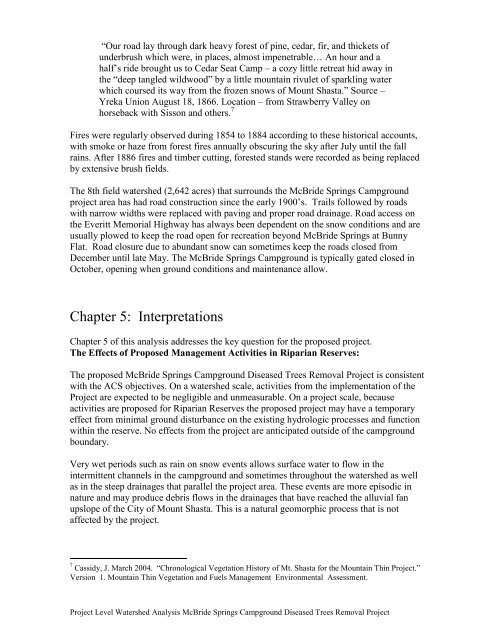Project Level Watershed Analysis McBride Springs Campground ...
Project Level Watershed Analysis McBride Springs Campground ...
Project Level Watershed Analysis McBride Springs Campground ...
You also want an ePaper? Increase the reach of your titles
YUMPU automatically turns print PDFs into web optimized ePapers that Google loves.
“Our road lay through dark heavy forest of pine, cedar, fir, and thickets of<br />
underbrush which were, in places, almost impenetrable… An hour and a<br />
half’s ride brought us to Cedar Seat Camp – a cozy little retreat hid away in<br />
the “deep tangled wildwood” by a little mountain rivulet of sparkling water<br />
which coursed its way from the frozen snows of Mount Shasta.” Source –<br />
Yreka Union August 18, 1866. Location – from Strawberry Valley on<br />
horseback with Sisson and others. 7<br />
Fires were regularly observed during 1854 to 1884 according to these historical accounts,<br />
with smoke or haze from forest fires annually obscuring the sky after July until the fall<br />
rains. After 1886 fires and timber cutting, forested stands were recorded as being replaced<br />
by extensive brush fields.<br />
The 8th field watershed (2,642 acres) that surrounds the <strong>McBride</strong> <strong>Springs</strong> <strong>Campground</strong><br />
project area has had road construction since the early 1900’s. Trails followed by roads<br />
with narrow widths were replaced with paving and proper road drainage. Road access on<br />
the Everitt Memorial Highway has always been dependent on the snow conditions and are<br />
usually plowed to keep the road open for recreation beyond <strong>McBride</strong> <strong>Springs</strong> at Bunny<br />
Flat. Road closure due to abundant snow can sometimes keep the roads closed from<br />
December until late May. The <strong>McBride</strong> <strong>Springs</strong> <strong>Campground</strong> is typically gated closed in<br />
October, opening when ground conditions and maintenance allow.<br />
Chapter 5: Interpretations<br />
Chapter 5 of this analysis addresses the key question for the proposed project.<br />
The Effects of Proposed Management Activities in Riparian Reserves:<br />
The proposed <strong>McBride</strong> <strong>Springs</strong> <strong>Campground</strong> Diseased Trees Removal <strong>Project</strong> is consistent<br />
with the ACS objectives. On a watershed scale, activities from the implementation of the<br />
<strong>Project</strong> are expected to be negligible and unmeasurable. On a project scale, because<br />
activities are proposed for Riparian Reserves the proposed project may have a temporary<br />
effect from minimal ground disturbance on the existing hydrologic processes and function<br />
within the reserve. No effects from the project are anticipated outside of the campground<br />
boundary.<br />
Very wet periods such as rain on snow events allows surface water to flow in the<br />
intermittent channels in the campground and sometimes throughout the watershed as well<br />
as in the steep drainages that parallel the project area. These events are more episodic in<br />
nature and may produce debris flows in the drainages that have reached the alluvial fan<br />
upslope of the City of Mount Shasta. This is a natural geomorphic process that is not<br />
affected by the project.<br />
7 Cassidy, J. March 2004. “Chronological Vegetation History of Mt. Shasta for the Mountain Thin <strong>Project</strong>.”<br />
Version 1. Mountain Thin Vegetation and Fuels Management Environmental Assessment.<br />
<strong>Project</strong> <strong>Level</strong> <strong>Watershed</strong> <strong>Analysis</strong> <strong>McBride</strong> <strong>Springs</strong> <strong>Campground</strong> Diseased Trees Removal <strong>Project</strong>
















